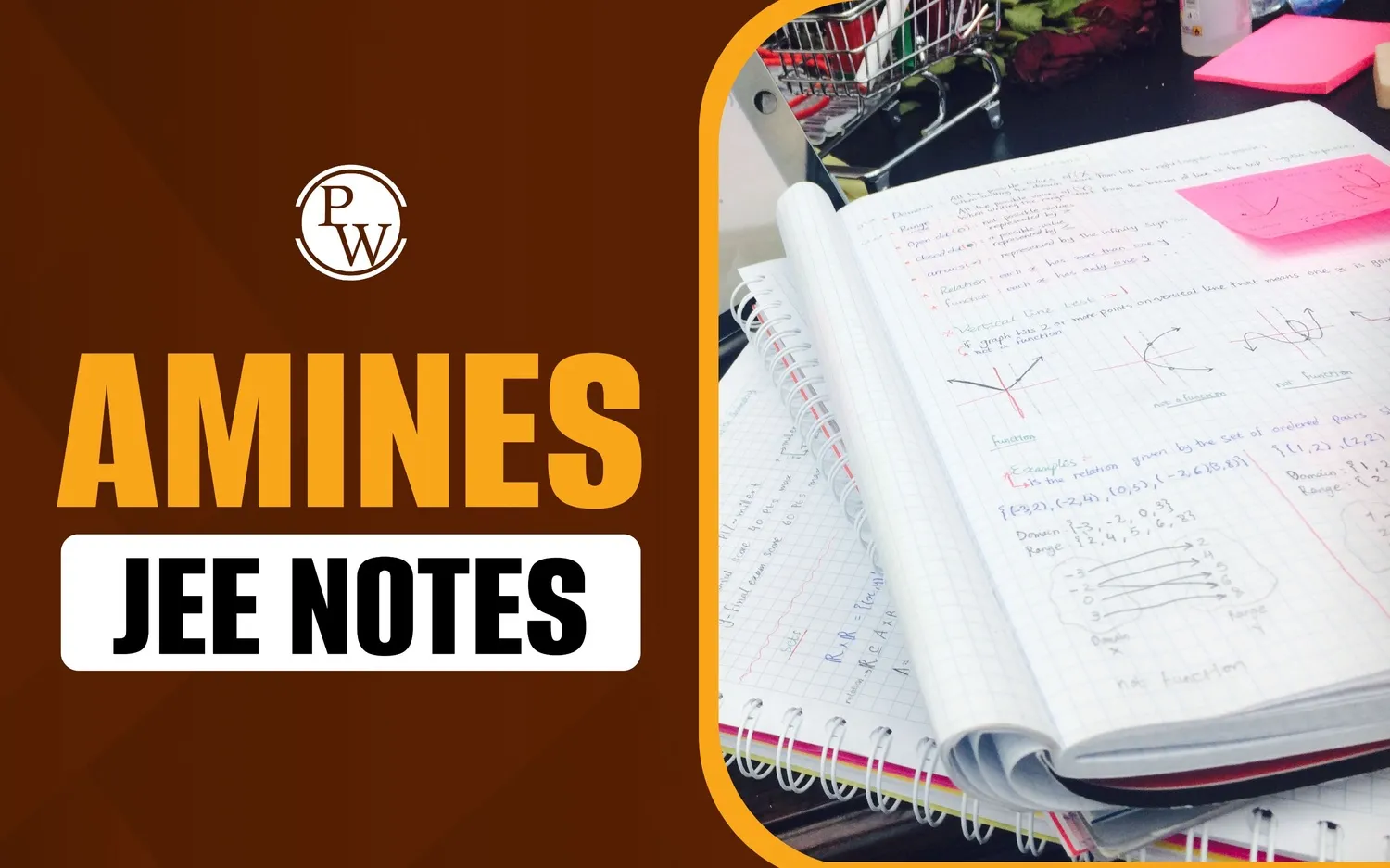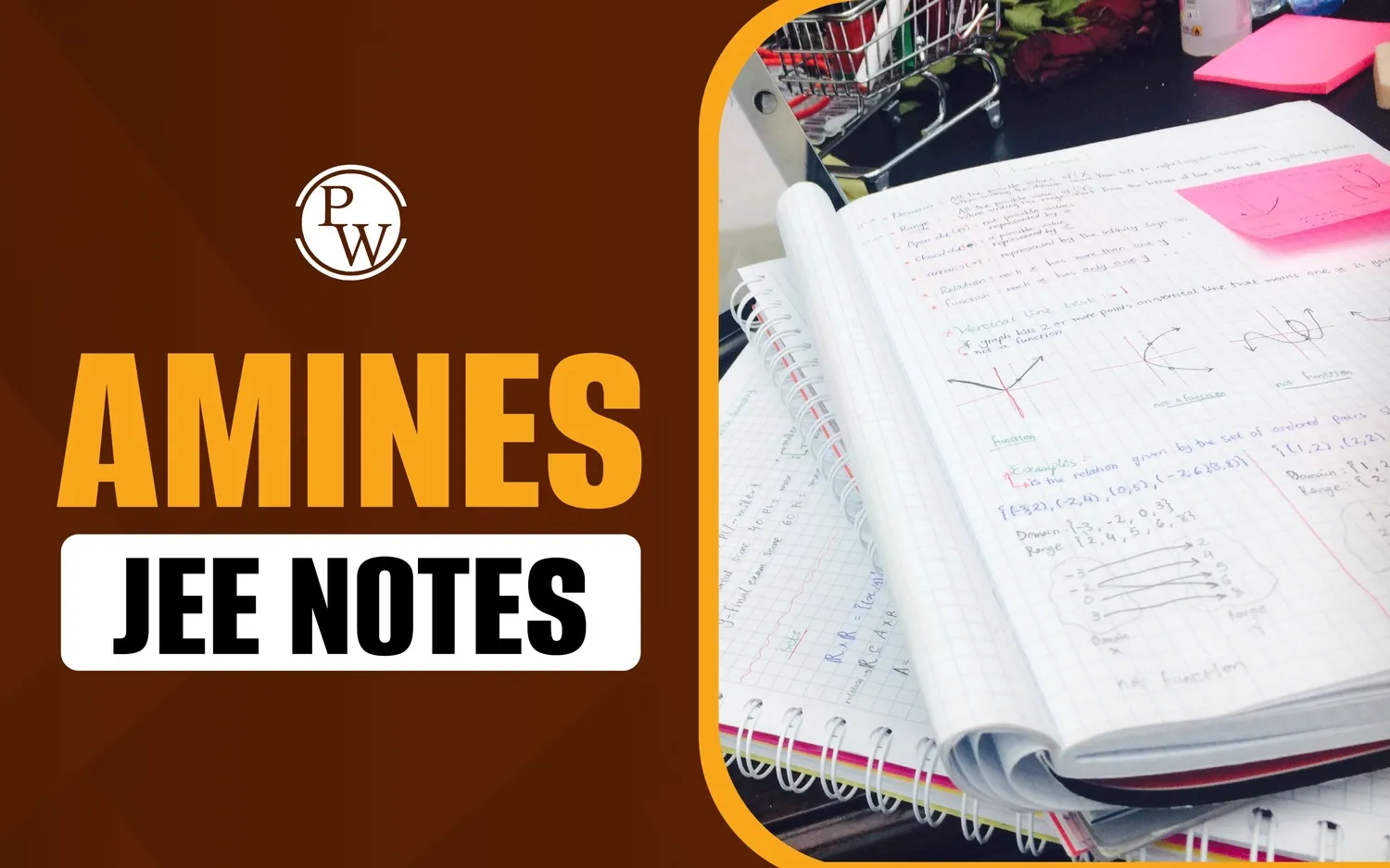

Amines JEE Notes: These are organic compounds derived from ammonia (NH₃) by replacing one or more hydrogen atoms with alkyl or aryl groups. They are classified as primary (1°), secondary (2°), and tertiary (3°) amines based on the number of carbon groups attached to nitrogen. These help students to understand the Amines group better.
Important topics for JEE include structure, classification, nomenclature, physical and chemical properties, methods of preparation (from alkyl halides, amides, nitro compounds), and reactions such as Hoffmann bromamide degradation and diazotization.
Aromatic amines like aniline are also important. Understanding basicity, electronic effects, and distinguishing tests (Carbylamine, Hinsberg) is key to solving conceptual and mechanism-based JEE questions. Students can check all the important questions from here.
Amines JEE Notes PDF
To help you prepare effectively for JEE Chemistry, we have provided a complete Amines JEE Notes PDF below. This Amines JEE PDF covers all important concepts, reactions, and mechanisms related to amines clearly and concisely for the students.
The PDF includes theory, short tricks, and solved examples designed to boost your understanding and problem-solving skills. Download the Amines Notes PDF below to revise important topics quickly and strengthen your preparation for upcoming JEE Main and Advanced exams.
| Amines JEE Notes PDF | |
| Amines JEE Notes | Download PDF |
Amines Important Questions JEE
To help you master this important Organic Chemistry topic, we have listed the most important Amines questions for JEE below.
These cover key concepts, reactions, and mechanisms frequently asked in JEE Main and Advanced. Go through these questions carefully to strengthen your understanding and boost your exam preparation.
1. What are amines?
Amines are organic compounds derived from ammonia (NH₃) where one or more hydrogen atoms are replaced by alkyl or aryl groups.
2. How are amines classified?
Amines are classified as:
-
Primary (1°): One alkyl/aryl group (R–NH₂)
-
Secondary (2°): Two alkyl/aryl groups (R₂NH)
-
Tertiary (3°): Three alkyl/aryl groups (R₃N)
3. How are amines named according to the IUPAC system?
In IUPAC nomenclature, amines are named as alkylamines (e.g., methylamine, ethylamine). If –NH₂ is a substituent, it is named as an amino group, e.g., 2-aminopropane.
4. What is the basic character of amines due to?
The basicity of amines arises from the presence of a lone pair of electrons on nitrogen, which can accept protons (H⁺).
5. Arrange the basicity of amines in aqueous medium:
In aqueous medium:
2° amine > 1° amine > 3° amine > NH₃
(due to hydration and solvation effects)
6. What is Hoffmann bromamide degradation?
It is a reaction where an amide is converted to a primary amine with one carbon less using Br₂ and NaOH.
Example:
RCONH₂ → RNH₂ + CO₂
7. How are amines prepared from alkyl halides?
By ammonolysis — treating alkyl halides with ammonia:
R–X + NH₃ → R–NH₂ + HX
8. What happens when nitro compounds are reduced?
Reduction of nitro compounds gives amines.
Example:
R–NO₂ → R–NH₂ (using Sn/HCl or Fe/HCl)
9. What is the Carbylamine reaction?
Primary amines react with chloroform and alcoholic KOH to form an offensive-smelling isocyanide (carbylamine).
R–NH₂ + CHCl₃ + 3KOH → R–NC + 3KCl + 3H₂O
10. What is Hinsberg’s test used for?
It distinguishes primary, secondary, and tertiary amines using benzene sulphonyl chloride (C₆H₅SO₂Cl).
11. What is diazotization?
The process of converting a primary aromatic amine into a diazonium salt using NaNO₂ and HCl at 0–5°C.
Example:
C₆H₅NH₂ + NaNO₂ + HCl → C₆H₅N₂⁺Cl⁻ + 2H₂O
12. What is coupling reaction of diazonium salts?
Aromatic diazonium salts react with phenols or aromatic amines to form azo compounds (colored dyes).
Example:
C₆H₅N₂⁺Cl⁻ + C₆H₅OH → C₆H₅–N=N–C₆H₄OH
13. What is Gabriel phthalimide synthesis?
A method to prepare pure primary amines from phthalimide and alkyl halide.
Example:
C₆H₄(CO)₂NH + R–X → R–NH₂ (after hydrolysis)
14. Why are anilines less basic than aliphatic amines?
In aniline, the lone pair on nitrogen is delocalized into the aromatic ring, reducing its availability for protonation.
15. Write the structure of Benzene Diazonium Chloride and its use.
Structure: C₆H₅–N₂⁺Cl⁻
It is used in azo dye synthesis and as an intermediate for producing phenols, chlorobenzene, and iodobenzene.
Benefits of Using Amines JEE Notes
Preparing for JEE Chemistry becomes easier with our Amines JEE Notes. These notes cover all important concepts, reactions, and mechanisms in a concise and exam-focused manner. Check below to explore the key benefits of using Amines Notes to strengthen your understanding and boost your JEE Main and Advanced preparation.
1. Complete Concept (Amines) Coverage
The Amines JEE Notes include all key concepts — from classification, nomenclature, and preparation methods to chemical properties, basicity, and important reactions — ensuring that every topic in the syllabus is clearly explained.
2. JEE Exam-Focused Approach
These notes are made for students according to the latest JEE Main and Advanced syllabus, highlighting high-weightage concepts and frequently asked reactions, helping students focus on what truly matters for the exam.
3. Easy to Revise for JEE or Advanced Exam
Well-structured and simple summaries are revised faster. The notes include short tricks, mechanisms, and formulae that can be quickly reviewed before exams to save time and improve recall. These notes will help in a complete revision.
4. Visual and Tabular Clarity for the JEE Exams
Reactions, mechanisms, and comparison tables (e.g., basicity trends, differences between amines and amides) are neatly presented for better understanding and long-term memory retention.
5. Strengthens Problem-Solving Skills
Each concept is supported by examples and application-based questions, helping students link theory with JEE-style numerical and conceptual problems effectively. Focus on concepts not only learning part.
6. Time-Saving Resource
Instead of reading lengthy chapters from multiple sources, these notes provide a compact, one-stop solution for last-minute revision and quick concept brushing. Also, do not leave your doubts and ask teachers and your friend group for help.
7. Useful for Both JEE Main and Advanced
The notes cover both fundamental concepts (for JEE Main) and mechanistic understanding (for JEE Advanced) — making them ideal for all levels of preparation. Concepts are useful for both exams.
8. Boosts Confidence and Accuracy
By revising all important reactions and tests (like Carbylamine, Hoffmann, Hinsberg), you gain more conceptual clarity, which boosts accuracy during the exam. Also, confidence will help students perform better in the JEE Exam.
